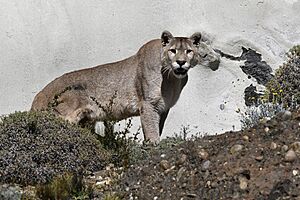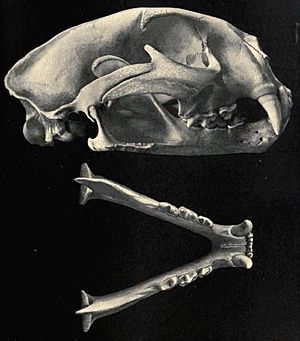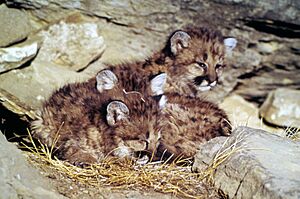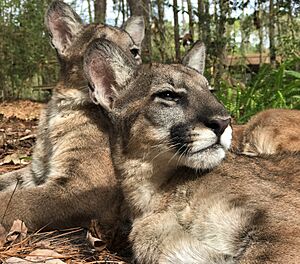Cougar facts for kids
Quick facts for kids Cougar |
|
|---|---|
 |
|
| A North American cougar in Glacier National Park, United States | |
| Conservation status | |
| Scientific classification | |
| Genus: |
Puma
|
| Species: |
concolor
|
| Subspecies | |
Also see text |
|
 |
|
| Cougar range (without recent confirmations across northern Canadian territories, eastern U.S. states, and Alaska) | |
The cougar (Puma concolor), also known as puma, mountain lion, catamount, or panther, is a large wild cat that lives in the Americas. You can find cougars in North, Central, and South America. This makes them one of the most widespread land mammals in the entire Western Hemisphere! Their territory stretches from Canada's Yukon all the way down to the southern Andes Mountains in Patagonia. Cougars are very adaptable animals, meaning they can live in almost any type of habitat, from dense forests to rocky mountains and even open plains. They especially like places with thick bushes and rocks, which help them hide and hunt.
Cougars are mostly solitary animals, preferring to live alone. They are excellent ambush predators, meaning they sneak up on their prey and then pounce. Their main food is large animals like deer, but they also hunt smaller creatures like rodents. Cougars are territorial, marking their areas to let other cougars know it's their space. Even though they are big and powerful, cougars are usually shy and try to avoid people. It's very rare for them to attack humans, but it's always good to know how to stay safe if you are in an area where cougars live.
The cougar is currently listed as a species of "Least Concern" by conservation experts. However, their populations have decreased in many areas. This is mainly due to hunting in the past and humans building more homes and farms in cougar habitats. Protecting their homes and ensuring they have enough space to roam is very important for the future of these amazing cats.
Contents
Many Names for the Cougar
The cougar holds a special record for having the most names of any animal, with over 40 different names in English alone! The word cougar comes from the Portuguese word çuçuarana, which originally came from the Tupi language.
The name puma is commonly used in Latin America and many parts of Europe. It comes from the Quechua language. In the western United States and Canada, people often call them mountain lions. Another old name, catamount, is a shorter way of saying "cat of the mountain." Sometimes, people also call them panthers, especially in the southern United States.
Cougar Family Tree and History
Scientists gave the cougar the scientific name Felis concolor in 1771. Later, it was placed in the genus Puma. Cougars belong to the Felinae family, which includes many smaller cats. Interestingly, the cougar's closest relatives are the jaguarundi and the cheetah!
Cougar Subspecies
For a long time, scientists thought there were many different types of cougars, called subspecies. But with modern genetic testing, they found that many of these cougars are very similar. Today, most scientists recognize two main subspecies:
- The P. c. concolor, which lives in most of South America.
- The P. c. couguar, found in North and Central America, and parts of northwestern South America.
The Florida panther is a special group within the North American cougar subspecies that is very important to protect.
How Cougars Evolved
The cat family, called Felidae, is thought to have started in Asia about 11 million years ago. Scientists believe that the ancestors of today's cougars, along with other cat lineages, crossed a land bridge called Beringia into the Americas about 8 to 8.5 million years ago. Later, about 2 to 4 million years ago, these North American cats moved into South America when the Isthmus of Panama formed, connecting the two continents.
Scientists think that the original cougar populations in North America might have disappeared around 10,000 years ago during a time when many large animals went extinct. Then, cougars from South America moved north and repopulated North America. The oldest cougar fossils found in South America are from about 1.2 million years ago.
What Cougars Look Like
A cougar's head is round, and its ears stand straight up. They have very strong front legs, neck, and jaws, which are perfect for catching and holding onto large prey. Each of their hind paws has four claws that can retract (pull back), and their front paws have five, including a special claw called a dewclaw. Their larger front feet and claws are great for grabbing prey.
Cougars are slender and very agile. They are the fourth-largest cat species in the world. Adult cougars stand about 60 to 90 centimeters (2 to 3 feet) tall at the shoulders. Males can be around 2.4 meters (8 feet) long from nose to tail tip, while females average about 2.05 meters (6.7 feet). Their long tail usually makes up about 63 to 95 centimeters (2 to 3 feet) of their total length. Males typically weigh between 53 and 72 kilograms (117 to 159 pounds), and females usually weigh between 34 and 48 kilograms (75 to 106 pounds). Cougars tend to be smaller closer to the equator and larger closer to the Earth's poles.
The largest cougar ever recorded weighed 105.2 kilograms (232 pounds) in 1901! In North America, male cougars average about 62 kilograms (137 pounds), and females average about 42 kilograms (93 pounds).
Cougar fur is usually a plain color, which is why their scientific name includes concolor, meaning "one color." Their coat is typically a tawny (light brown or yellowish-brown) color, but it can range from silvery-grey to reddish. They have lighter patches on their belly, jaws, chin, and throat. Baby cougars, called cubs, are born with spots and blue eyes, and they have rings on their tails. These spots fade as they grow older. Very rarely, a pure white cougar has been seen!
Cougars have large paws and the biggest hind legs in the entire cat family, which allows them to make incredible leaps and run very fast for short distances. They can jump from the ground up to 5.5 meters (18 feet) high into a tree! They are also the largest of the "small cats" that can purr.
Where Cougars Live and Their Homes
The cougar has the widest range of any wild land animal in the Americas. They live across 110 degrees of latitude, from the Yukon in Canada all the way to the southern Andes in Chile. While they were once found throughout eastern North America, most populations there disappeared, except for the Florida panther. However, cougars are slowly starting to return to some of their old territories.
Cougars can live in all kinds of forests, deserts (both lowland and mountainous), and even open areas with little plant life, up to very high elevations of 5,800 meters (19,000 feet). In places like the Santa Ana Mountains, they prefer steep canyons and rocky areas with dense bushes. In Mexico, they have been seen in the Sierra de San Carlos and in secondary forests in the Yucatán Peninsula. They have also been recorded in palm oil plantations in Colombia and bushland in Argentina, showing how adaptable they are to different environments, even those changed by humans.
Cougar Behavior and Lifestyle
The cougar is a keystone species in Western Hemisphere ecosystems. This means they play a very important role in keeping the environment healthy. They interact with many other species, both as prey and as predators, and their presence affects other animals in their habitat.
Hunting and What Cougars Eat
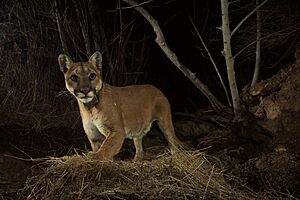
Cougars are expert hunters that eat mostly meat. They prefer large mammals like mule deer, white-tailed deer, elk, moose, mountain goat, and bighorn sheep. But they are also opportunistic, meaning they will hunt smaller prey if they get the chance. This can include rodents, rabbits, smaller carnivores, birds, and even domestic animals like pets. The size of the prey a cougar hunts often depends on its own body weight and where it lives. In North America, about 68% of their diet consists of hoofed animals like deer. The Florida panther is a bit different, often hunting wild hogs and armadillos.
Cougars are ambush predators. They stalk quietly through bushes, trees, or along ledges, waiting for the perfect moment. Then, they deliver a powerful leap onto the back of their prey and use a strong bite to the neck to suffocate it. They can even break the neck of smaller prey with a powerful bite. Cougars usually hunt one large animal about every two weeks. If a mother is raising cubs, she might hunt more often, sometimes every three days when her cubs are almost grown. After a kill, the cougar drags its meal to a hidden spot, covers it with branches, and returns to eat from it over several days.
Cougars and Other Wild Animals
Besides humans, no other animal regularly hunts adult cougars in the wild. However, cougars do have conflicts with other large predators and scavengers. In places like Yellowstone National Park, cougars share their habitat with grizzly bears, American black bears, and gray wolfes. The powerful grizzly bear is usually the dominant animal and can often scare cougars, wolves, or black bears away from their kills. Studies show that bears sometimes take over cougar kills, which means the cougar loses a valuable meal.
Gray wolves and cougars compete more directly for the same prey, especially in winter. Wolf packs can steal cougar kills, and there have been cases where wolves have killed cougars. However, in one-on-one fights, cougars can sometimes kill wolves. Wolves also affect where cougars live and hunt by controlling territories and prey. Both cougars and wolves can also hunt smaller predators like coyotes, keeping their numbers in check.
In areas where cougars and jaguars live in the same territory, like in parts of South America, jaguars tend to hunt larger prey. This helps reduce direct competition between the two big cats. Cougars are very good at hunting a wider variety of prey, including smaller animals.
Living Alone and Communicating
Cougars are mostly solitary animals. Only mothers and their cubs live together. Adult cougars rarely meet, except during mating season. Sometimes, young cougars of the same age might form temporary groups with their siblings before they go off on their own. Even though they are mostly alone, cougars seem to organize themselves into small communities, where the territories of dominant males overlap with those of several females. Cats within these areas might interact more often with each other than with outsiders.
Cougars are active at different times depending on where they live and what other animals are around. In some places, they are mostly active at night (nocturnal), while in others, they might be active during twilight hours (crepuscular) or even throughout the day (cathemeral). This often depends on when their prey is active or when they can avoid humans.
The size of a cougar's home range and how many cougars live in an area depend on the landscape, plants, and how much prey is available. Male cougars can have very large home ranges, from 150 to 1,000 square kilometers (58 to 386 square miles), while female ranges are usually about half that size. Male cougars mark their territories by making scrapes on the ground with their hind feet and marking them with urine and sometimes feces. If two males meet, they might make loud noises and even fight if neither backs down.
Cougars communicate using various sounds. When they are aggressive, they growl, spit, snarl, and hiss. During mating season, females make loud calls to attract mates, and males respond with similar sounds. Mothers and their cubs use whistles, chirps, and mews to stay in touch.
Reproduction and Life Cycle
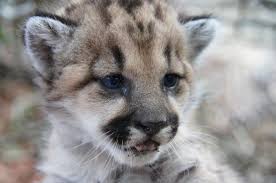
Female cougars are ready to have babies when they are between 18 months and three years old. They are in heat for about eight days during a 23-day cycle. The pregnancy lasts about 91 days. Both male and female cougars may mate with several partners.
Only the mother cougar takes care of the cubs. A litter usually has one to six cubs, but most often two. The mother finds safe places like caves or rocky alcoves to use as dens for her cubs. Cubs are born blind and completely depend on their mother at first. They start to eat solid food around three months old. As they grow, they go on trips with their mother, first visiting kill sites and then, after about six months, starting to hunt small prey on their own.
Young cougars stay with their mothers for one to two years. When the mother is ready to have more cubs, her older offspring must leave to find their own territories. Males tend to travel farther than females when they disperse. Studies show that cougars who travel farthest from their mother's home range often face more dangers, sometimes from conflicts with other cougars.
In the wild, cougars usually live for 8 to 13 years, with an average of 8 to 10 years. Some have been known to live up to 18 years in the wild and as long as 20 years in captivity. Cougars can die from illness, starvation, accidents, or sometimes from hunting in areas where it's allowed.
Protecting Cougars
Since 2008, the cougar has been listed as a species of "Least Concern" by the IUCN Red List, which means they are not currently at high risk of extinction globally. However, they are also listed on CITES Appendix II, which means their trade is controlled to prevent them from becoming endangered. Hunting cougars is against the law in many countries, including California, Costa Rica, Honduras, Guatemala, Panama, Venezuela, Colombia, Brazil, Chile, Paraguay, Uruguay, and most of Argentina. In other places like Canada, Mexico, Peru, and the United States, hunting is regulated, meaning there are rules about when and how they can be hunted.
Creating wildlife corridors (safe paths for animals to travel) and protecting large areas of their habitat are very important for cougar populations to thrive. Research shows that cougars have a low risk of extinction in areas larger than 2,200 square kilometers (850 square miles). Even a few new cougars entering a population each decade can greatly help them survive, highlighting how important these habitat corridors are.
The Florida panther, a special group of cougars, has extra protection under the Endangered Species Act in the United States. Projects like the Texas Mountain Lion Conservation Project work to teach people about cougars and help reduce problems between cougars and landowners.

Cougars are threatened by the loss of their habitat, their habitats becoming broken up into smaller pieces, and a decrease in their prey due to illegal hunting. In Florida, busy roads cause many accidents involving cougars. Highways are a big barrier that stops cougars from moving around and finding new territories. In California, cougar populations are becoming separated as more people move into the state and build more roads and buildings.
Conflicts between humans and cougars are more common in areas where many people live close to cougar habitats, especially where there are also many farm animals. These conflicts are generally less frequent in areas far away from roads and towns.
Cougars and People
Staying Safe in Cougar Country
As more people move into areas where cougars live, their territories sometimes overlap. It's important to remember that attacks on humans are extremely rare. Cougars usually don't see humans as prey because they learn what to hunt from their mothers. In a study, wild cougars rarely showed threatening behavior to researchers who came close, except for mothers with cubs. Attacks on people or pets can happen if a cougar gets used to being around humans or if it is very hungry. Young cougars, especially when they leave their mothers to find new homes, might be more likely to have conflicts.
Between 1890 and 2004 in North America, there were 88 confirmed cougar attacks on humans, with 20 resulting in fatalities. This shows how rare these events are over a long period. For example, in March 2024, there was a fatal attack in California, the first in that state in 20 years.
If you ever encounter a cougar, here are some important safety tips:
- Do not run! Running might trigger a cougar's instinct to chase.
- Make yourself look big. Raise your arms, open your jacket, and stand tall.
- Make noise. Shout loudly and firmly.
- Maintain eye contact. Do not turn your back on the cougar.
- Fight back if attacked. Use sticks, rocks, or even your bare hands. Fighting back is often effective in making the cougar stop.
- Children are at greater risk, so always supervise them closely in cougar habitats.
When cougars do attack, they usually aim for the neck, head, or spine. Injuries to these areas can be serious. Before an attack, cougars might show unusual behavior, like being active during the day, not being afraid of humans, or stalking people.
In South America, cougars are known to be very shy and rarely attack people. Old legends even say they protected people from jaguars! However, very rare attacks have happened. For example, in 1997, a young child was killed by a female puma in Iguazú National Park in Argentina. This particular puma had been raised in captivity and then released, which might have made it less fearful of humans. In 2019, an elderly man in Argentina was injured while defending his dog from a cougar.
Cougars and Farm Animals
In the past, cougars were seen as a big problem for ranchers, similar to wolves. Cougars sometimes hunt farm animals like calves, goats, and sheep. For example, in Texas in 1990, cougars were confirmed to have killed a small percentage of livestock, with sheep being the most frequently attacked. Sometimes, a cougar might kill many animals in one attack, which is called "surplus killing."
When a cougar kills an animal, it usually bites the back of the neck, head, or throat. You might also see claw marks on the sides and underside of the prey. These marks help tell the difference between a cougar kill and one made by smaller predators like coyotes or dogs.
Interestingly, hunting cougars to reduce attacks on livestock can sometimes have the opposite effect. Studies have shown that killing cougars can actually lead to more problems with livestock and human-cougar conflicts the following year. This might happen because removing older, experienced cougars who have learned to avoid people allows younger, less experienced males to move into the area. These younger cougars might be more likely to hunt farm animals or come into contact with humans. Cougars also sometimes prey on dogs, but this happens less often.
Cougars in Stories and Legends
The grace and power of the cougar have been admired by many indigenous peoples of the Americas. The ancient Inca city of Cusco is even said to have been designed in the shape of a cougar! The animal also gave its name to Inca regions and people. The Moche people often showed cougars in their pottery. The Inca sky and thunder god, Viracocha, was sometimes linked to the cougar.
In North America, cougars appear in the stories of the Hocąk (Ho-Chunk) and Cheyenne people, among others. To the Apache and Walapai tribes, the sound of a cougar's cry was sometimes seen as a sign of death. The Algonquins and Ojibwe believed the cougar lived in the underworld and was mischievous, while it was considered a sacred animal by the Cherokee.
Images for kids
See also
 In Spanish: Puma concolor para niños
In Spanish: Puma concolor para niños



